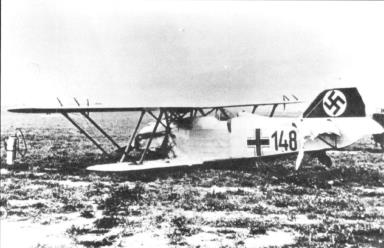
The Fiat CR.32 was designed by the noted aeronautical engineer Celestino Rosatelli. It was derived from the earlier Fiat CR.30. The CR.30, being a relatively fast and maneuverable aircraft in its time, had received limited production orders for the type from the Regia Aeronautica but, within the space of 12 months, it had been superseded by the newer CR.32. In comparison to the CR.30, the CR.32 featured a more streamlined and smaller fuselage, resulting in a more compact aircraft overall. According to aviation author Gianni Cattaneo, the type was the product of a decade-old formula developed not only by Rosatelli but by his predecessors as well.
On 28 April 1933, the prototype CR.32, which was designated as the MM.201, performed its maiden flight from the Fiat company airstrip at Turin. By the end of the year, the first production examples were already arriving with front line units of the Regia Aeronautica. Mass production of the type would proceed over the following years. Between 1933 and 1938, a total of four distinct variants of the CR.32 were developed: the standard, bis, ter, and quater. The CR.32 bis was provided with a more powerful Fiat A.30R V12 engine as well as two additional machine guns, while the ter and the quater retained the original armament arrangement, differing by the adoption of improved sights and instrumentation.
By 1938, the CR.32 had been rendered obsolete by advances in the field of aviation, including the arrival of a new generation of monoplane fighters, which were capable of superior performance. The CR.32 was directly succeeded by the Fiat CR.42, which was a further advancement of the biplane platform, having been derived from the CR.32 itself. During the development of this improved derivative, a total of four CR.32s were converted to serve as prototypes, an act which highlighted the strong connection between the two fighters.
The Fiat CR.32 was a highly manoeuvrable biplane fighter aircraft; its agility was a major quality of the design. Its fuselage shared the same structure as the earlier CR.30, utilizing aluminium and steel tubes covered by duraluminium on the nose up to the cockpit, on the back, in the lower section under the tail, while a fabric covering was used on the sides and belly. According to Cattaneo, the fuselage was very robust for the time. The CR.32 was fitted with a fixed undercarriage arrangement, which incorporated two main legs, furnished with independent wheels housed within fairings and hydraulic shock absorbers; braking was achieved via a pneumatic system.
The wings and tail used a mixed composition, similar to the fuselage, composed of a pair of aluminium alloy tubular spars and square tubes, which were covered by fabric. According to Cattaneo, the atypical wing strut arrangement of the CR.32 had been first used on the Ansaldo SVA of 1917. Another notable feature was that the lower wing was shorter than the upper wing, making the fighter a sesquiplane. Ailerons were only present upon the upper wings, which were balanced via out-rigged tabs mounted upon steel struts. The empennage, which was largely composed of aluminium tubes, featured a variable incidence tailplane and a dynamically-balanced elevator.
The cockpit of the CR.32 normally seated only a single pilot, who was provisioned with an adjustable seat and a parachute, the latter of which being stored within the squab. Although this was considered to be fully instrumented from the era, the RA.80-1 radio set was only an optional piece of equipment. Other equipment included a fire extinguisher, gun camera, an oxygen system for the pilot; both an optical gunsight and survey camera could also be installed as optional item. The armament initially included a pair of 7.7 mm Breda-SAFAT machine guns (which was later substituted for a pair of 12.7 mm Breda-SAFAT guns, which were fitted on top of the engine cowling; each gun had an ammo capacity of 350 rounds each. Later examples were also furnished with a pair of hard points, which could accommodate up to 12 2,5 kg bombs, a pair of 50 kg bombs, or a single 100kg bomb.
The CR.32 was powered by a single water-cooled Fiat A.30 R.A. V12 engine. Designed in 1930, it was a 60° V 12, producing up to 600 hp at 2,600 rpm .It drove a 2.82 meter two-blade metal propeller with pitch only adjustable on the ground, not in flight. The engine did not use the usual aviation gasoline, but instead ran on a mixture of petrol (55%), alcohol (23%) and benzol (22%). The main fuel tank, which was located between the engine and cockpit, carried 325 litres . There was another small 25 liter auxiliary tank positioned in a streamlined "torpedo" fairing in the center of the upper wing.
In spring 1936, 45 CR.32s were ordered by Austria to equip Jagdgeschwader II at Wiener Neustadt. In March 1938, following the Anschluss with neighbouring Nazi Germany, the Austrian units were absorbed into the Luftwaffe, and, after a brief period, the 36 remaining aircraft were handed over to Hungary


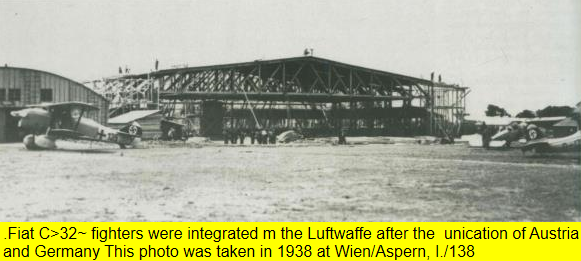
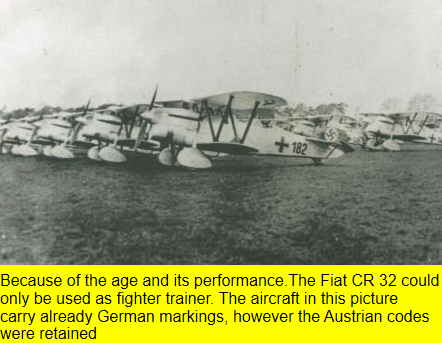
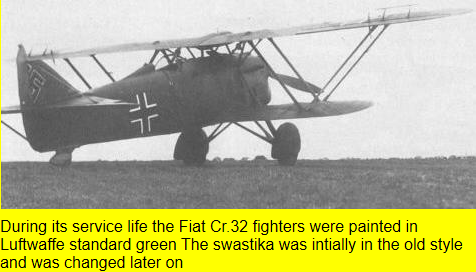
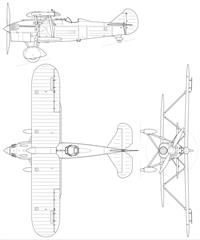
| Type |
Single seat fighter |
| Engine |
1 Fiat A 30 RA bis |
| Dimensions |
Length 7,47 m, height 2,36 m , span 9,5 m, wing area 22,1 m2 |
| Weights |
Empty 1455 kg, loaded 1975 kg |
| Performance |
Max. speed 360 km/h, range 781 km, service ceiling 8800 m, rate of climb 9 m/sec. |
| Armament |
2 7,7 mm or 12,7 mm Breda-SAFAT machine guns , up to 100 kg bombload |






